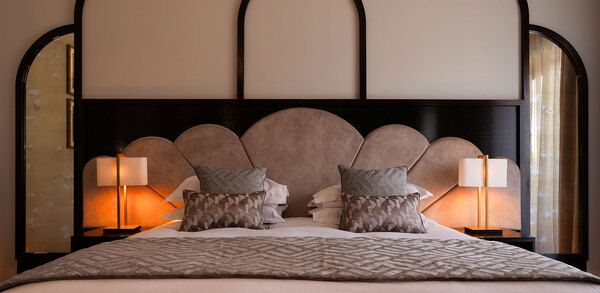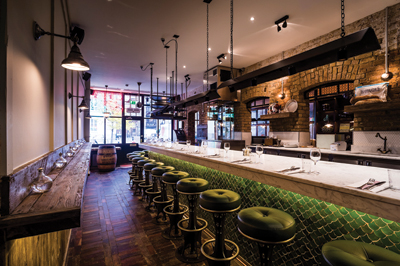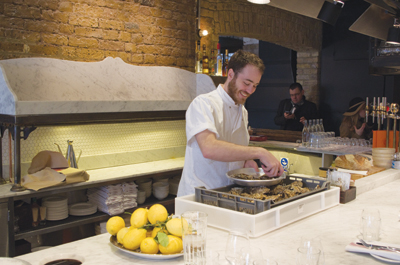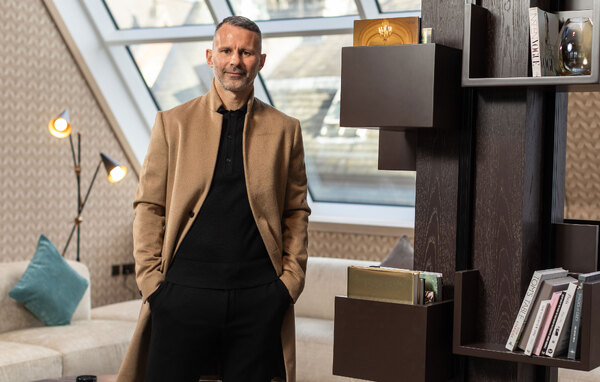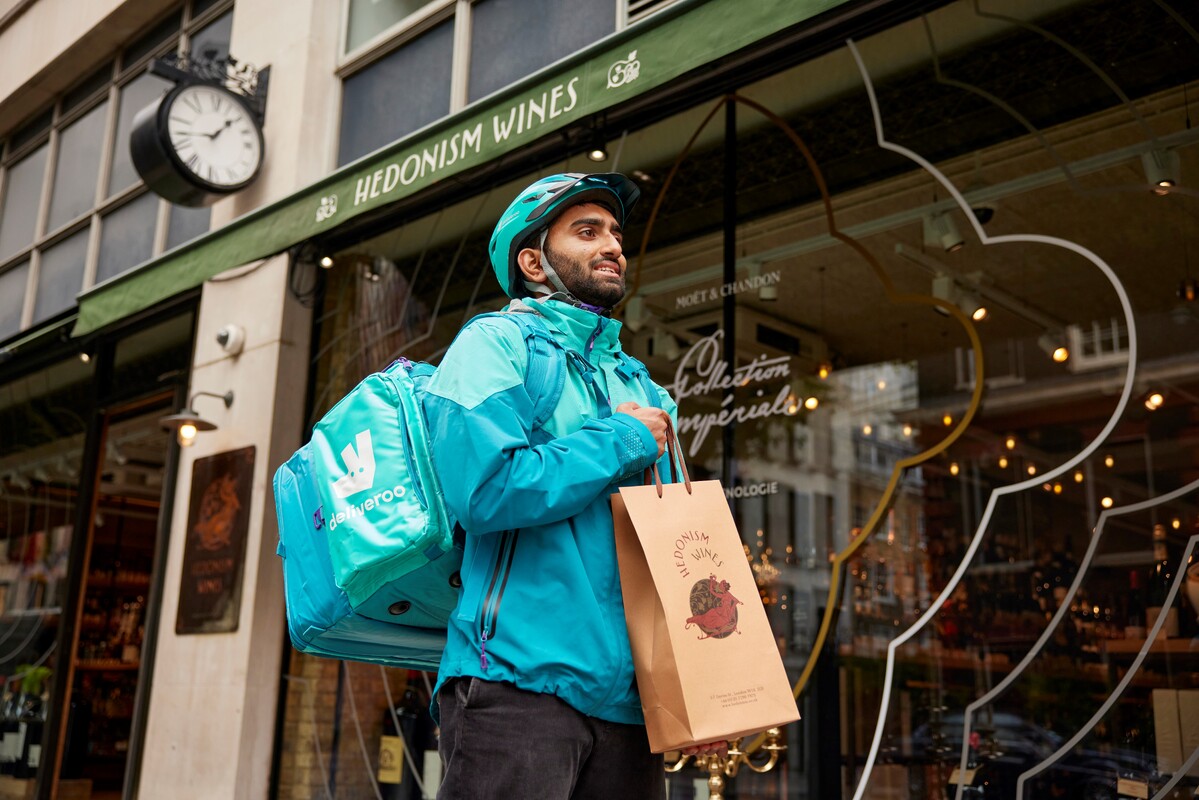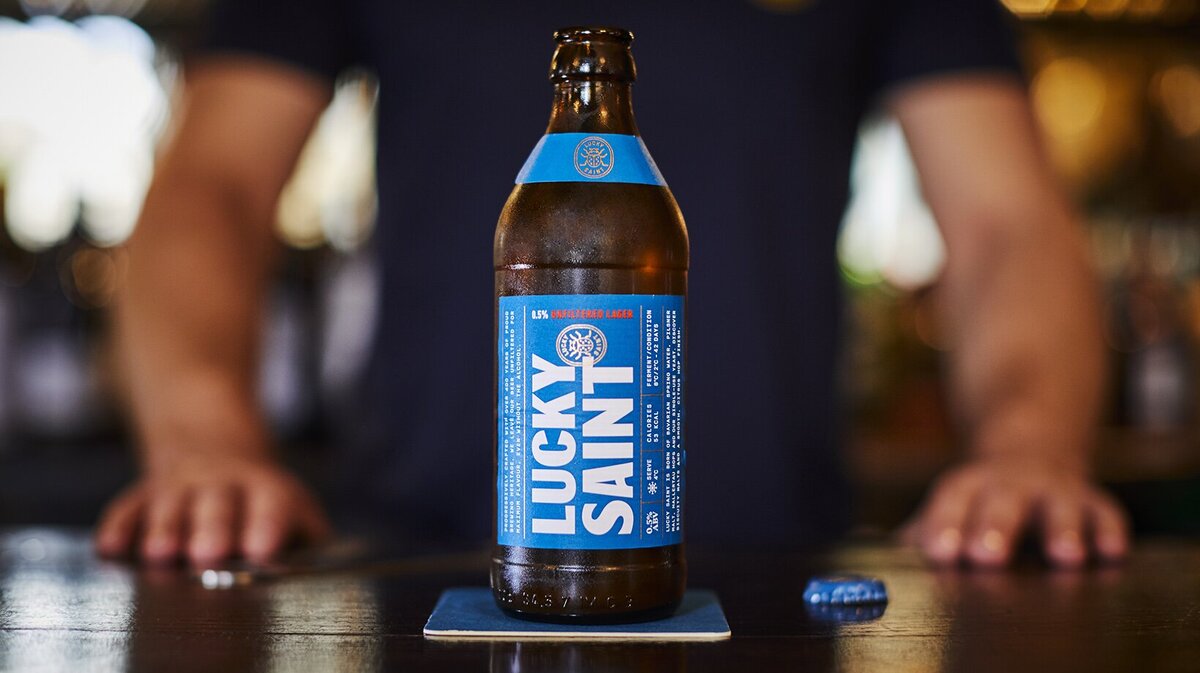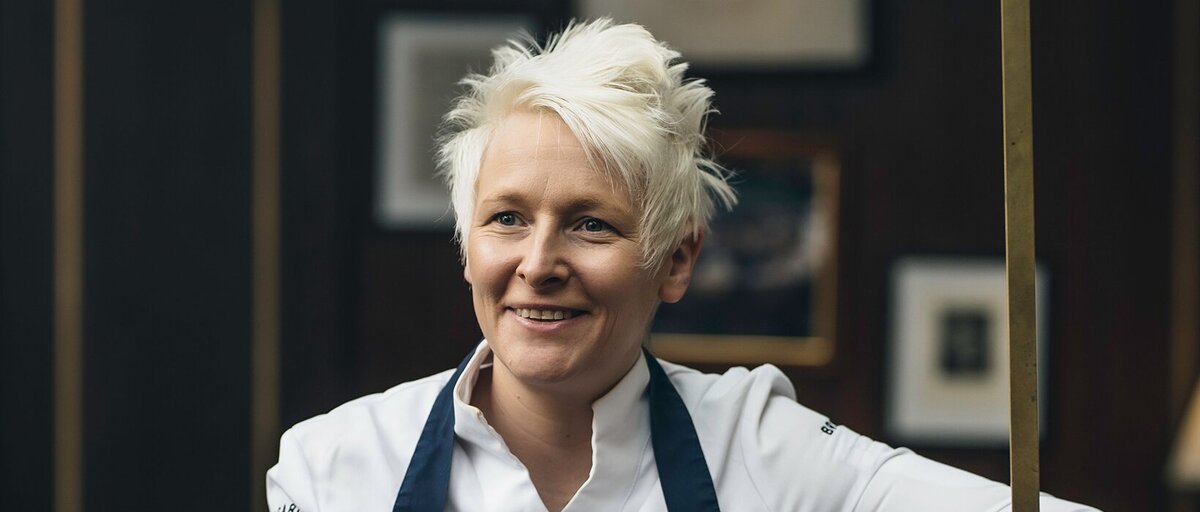Wright Brothers: Seafood cocktail
Ben Wright is talking grand. âTo have a Wright Brothers seafood experience in every neighbourhood in London â" that is the goal.â He certainly looks grand. Seated next to business partner Robin Hancock in their new Spitalfields restaurant, the founders of the growing Wright Brothers oyster empire are positioned rather surreally under eight sprawling bronze tentacles, giving them the air of Jules Verne mariners battling a giant squid, or rather pleasantly talking it down.
âThen again there was no real plan at the start,â interjects the white-haired, waistcoated Hancock. âItâs come a long way from driving around with a palette of oysters in the back of my Peugeot and all the windows open so they stayed cool.â
A long way indeed: from barrow-boy oyster peddlers to multi-site restaurateurs â" not to mention oyster farmers, wholesalers and consultants â" in the space of a decade. Now, their fourth site, the new 86-cover Spitalfields restaurant (they already have restaurants in Londonâs Borough and Soho and a pub in Cornwall) is the latest crowning glory, with a list of regulars including East End glitterati such as Tracey Emin and Gilbert and George.
âThis feels like the neighbourhood restaurant that we want to have,â says Wright. âItâs far more akin to what we feel comfortable with. Thereâs a lack of good seafood experiences in London. There are lots of good seafood restaurants â" but they are based more around the restaurant experience than the seafood experience.â
A seafood experience as opposed to a seafood restaurant? Such sentiment could be in danger of sounding at best fluffy, at worst pretentious. That is, until you visit the new restaurant and understand exactly what they mean. Predominantly one long, oblong marble bar, populated by waiters who never seem to be without a platter of oysters or seafood in their hand, itâs a far more informal vibe than some of Londonâs other celebrated seafood haunts.
Sea life
It also offers almost every shellfish under the deep blue sea â" oysters come in seven different varieties, alongside whelks, winkles, cockles, Scottish langoustines, raw mussels in their shells and more elaborate dishes such as crab croquettes and cuttlefish in black ink rice. But the USP here does not lie in its informality, or in its extensive seafood-only menu. It does not even lie in Wright and Hancockâs control, as seafood wholesalers, over every aspect of the menu. The real selling point â" the seafood experience â" is downstairs, in Londonâs first ever on-site restaurant purification tanks.
âWe first saw them in a restaurant in Seattle and were likes kids in a toy shop,â says Wright. âThe types of oysters they had and the taste of them was amazing.â After deciding to install them in Spitalfields (against their better judgement as restaurateurs â" âMost people would have chosen the sensible option and put in a private dining room insteadâ) the pair are â¨only starting to fully explore a system that, in Hancockâs words, means Wright Brothers can serve up shellfish tasting âas if itâs just come out of the sea â" something you wonât experience elsewhere unless youâre on the coastâ.
Holding over 5,000 litres of artificial seawater in two separate tanks, the system took 21 days to build and three hours to fill. Is it an expensive folly or essential equipment?
âWe said to ourselves when we decided to install it that this was a gimmick, and we must really understand why we are using this tank,â says Wright. âOnly now are we starting to fully understand it and starting to ask questions like whether it would be cruel to keep octopuses in it. What doors can it open up? This is the kind of stuff that really, really excites us.â
Youâd think that a pair who visibly tingle at the thought of an octopus in a tank would have salt water running through their veins. But it wasnât always so. In fact, before becoming an oyster man, Wright was a lawyer in Paris. It was only when he agreed to translate for an oyster farmer friend who was trying to buy some beds in Jersey that he had his eyes opened to the industry, he says.
That deal never came off but Wright had discovered a passion, at first wanting to open a Paris oyster bar before deciding to bring what he had learnt back to the UK. âCompared with Paris, London had no oyster culture. They were seen as very expensive, elitist, and not easy to find,â says Wright. âYet when I dug into it, I found there once was a huge culture â" as strong as in Paris â" but it had disappeared.â
Intent on importing some of his friendâs oysters, he roped in his brother-in-law â¨Hancock â" who after a successful career as a music producer was looking for a new challenge, and swapped dealing with one type of slippery product to another â" and in 2003 they drove to collect their first palette of oysters from Grimsby. After cold-calling restaurants and knocking on doors, it wasnât long before their product was in demand.
âAs soon as people tried the oysters the phone started to ring,â says Wright. âNo one was doing what we were. Nobody really knew what a Fine de Claire was. Back then, 90% of chefs got their oysters from one company, and the other 10% from another. They were all the same and the quality was pretty poor.â
As business grew, the pair began yearning to sell their own product, rather than import someone elseâs. So when the opportunity came up in 2005 to run the Duchy of Cornwall oyster farm, after decades of dwindling productivity, they jumped at the chance.
Was it an easy ship to turn around? âMore like a tanker!â says Hancock. âItâs very challenging; a labour of love. But the oysters that do come out of there are second to none. And hopefully we are on course to become the biggest oyster farm in the UK.â
The original dream of an oyster bar was â¨still there, so when the opportunity to open in Londonâs Borough Market came up, the pair took the plunge on their first restaurant, and found initially that they were quite good at it, with their seafood-only menu a star attraction.
âWithout being very clever or knowledgeable, what we did at Borough just worked,â says Wright. âThere was the audience there and what we did was embraced. Moving on from there was the challenge, and it took us five years to do it.â
Yet with the pairâs second restaurant, in â¨Londonâs Soho, came some harsh realities. âThe biggest lesson we learnt was that you canât just pick up a successful restaurant, put it somewhere else and assume it will work. Weâve learnt just how hard it is to be a restaurateur â" thereâs no formula, no one answer; we are constantly on a learning curve.â
Likewise their Cornwall pub, the Ferryboat Inn near Falmouth; the pair saw the appeal of having a pub serving a London-style seafood experience overlooking their own oyster beds â" but then realised that there are eight months of the year when there are few tourists to woo, only locals.
âIn both places weâve learnt that we need to create more of a neighbourhood restaurant,â says Wright. âYouâve got to give people what they want, not what you want to give them.â
All of the lessons from these three restaurants have gone into Spitalfields, they say, with much emphasis placed on creating a neighbourhood appeal about the site. But as suppliers turned restaurateurs, how do their wholesale clients-cum-competitors now view them? âIf anything it has been a benefit [becoming restaurateurs],â says Hancock. âWe now know what it takes to run a restaurant. We know what margins restaurants have, we know about supply and demand and how prices fluctuate. We have such a broader understanding of the industry and a lot of the work we do is now on a consultancy business for people wanting to open oyster bars.â
Whatâs more, their Spitalfields restaurant is further benefiting their wholesale clients, with other London restaurants reaping the benefits of having their oysters kept purified and fresh in the siteâs tanks.
AÂ wholesale business, farm and plans for a Wright Brothers in every neighbourhood in London; but have they learnt any lessons from other restaurant groups that have tried, and failed, to bring seafood to the masses? âThe biggest lesson is donât be greedy,â says Hancock.
But will it be possible to fulfil their ambitions without getting outside help? âThatâs the question,â says Wright. âThere are a number of ways [to expand] and once you start taking outside investment, you get a list of conditions, often dictated by money. If that becomes your sole driver, you are likely to trip up. Itâs a balancing act. Thereâs a gap in the market for a neighbourhood seafood experience. Weâre going to bed this restaurant in first and go from there. If we get our core values right, the rest will come.â
Watch the video
THE WRIGHT BROTHERS RESTAURANT EMPIRE
Oyster and Porter House, Borough Market, London
Opened 2005
Seats 45
Weekly covers 1,500
Soho Oyster Porter House, Soho, London
Opened 2010
Seats 120
Weekly covers 2,500
Wright Brothers Spitalfields, London
Opened 2013
Seats 60 inside, 26 covered outside
Weekly covers data not available yet
The Ferryboat Inn, near Falmouth, Cornwall
Opened 2009
Seats 85
Weekly covers 2,450 (summer), 70 (winter)
EVERYONE BLAMES THE OYSTER
Oysters are still viewed by many as the Russian roulette of the dining world. You could have a terrific seafood experience, or you could end up with your head in the loo. And as the Norovirus outbreak at the Fat Duck showed in 2009, the latter can see lots of unwanted column inches.
âItâs nonsense,â says Wright. âYou are more likely to get ill off some unwashed lettuce. But everyone blames the oyster. Some people are allergic to oysters and donât know it, and it frustrates me that oysters get a bad press because of that reason.
âBut if something goes wrong, perhaps with hygiene systems, restaurateurs can find it easier to blame an oyster as well.â
A lot of the Wright Brothers consultancy work now is to do with shellfish hygiene, and with the tanks in Spitalfields, their systems of purification and screening couldnât be better. But will it have an effect, or will the oyster continue to cop the blame?
âItâll be interesting to see if it has any effect on peopleâs perceptions,â says Wright.
THE OYSTER CATCH
With many oyster beds in France and Ireland decimated by a killer herpes virus, and outbreaks in the UK, youâd be mistaken for thinking from national press coverage that we were on the edge of an oyster apocalypse.
âYes it is a huge challenge,â says Wright, âbut the oyster industry is cyclical and this is not the first time we have seen this.â
The shortfall in French farms is obviously pushing up prices for UK oysters â" bad news for consumers, but good news for the Duchy of Cornwall farm. âWe are significantly isolated to stay disease-free, but if it spreads it could well reach us,â says Wright.
French farms are responding by buying up beds in Scotland, while Hancock says that in the long term, it is just a case of managing the disease: âYou build it into your business plan and expect a much higher rate of mortality among oysters. You cope.â
CUTTING OUT THE MIDDLE MAN: SUPPLIERS TURNED RESTAURATEURS
Brindisa After opening her wholesale Spanish foods business in 1988, Brindisa founder Monika Linton waited until 2004 before she took the plunge into restaurants, when she was offered a site beside Londonâs Borough Market. As well as continuing to import more than 400 Spanish ingredients into the UK, Brindisa has grown to
add three more London sites in Soho, South Kensington and Shoreditch.
Chamberlain & Thelwell
Founded by Les Steadman, an eel-stand worker who opened his own fish stall then wholesale business in the 1950s, the company has supplied seafood to top-end London restaurants for more than 50 years and is today run by Steadmanâs sons. In 2001, the company opened a restaurant of its own, Chamberlainâs in Londonâs Leadenhall Market.
Gregg Wallace By the time barrow-boy-turned-mediapersonality Gregg Wallace opened his first restaurant in 2010, Wallace & Co in Londonâs Putney, he had already experienced periods of success during his business career.
After starting fruit and veg wholesalers George Allanâs Greengrocers in 1989, Wallace built the company up to reach a turnover of £7.5m. However, the company was later dissolved in 2007.
His move into restaurants has been less successful. Wallace & Co in Putney, London, opened to generally negative reviews, while Greggâs Bar and Grill in Londonâs Bermondsey, opened in 2012 to even worse reviews, and closed 18 months later. His greengrocers business collapsed in March 2013, and last month Wallace was forced to close Wallace and Co and sell its parent company Wallace Cafes.


